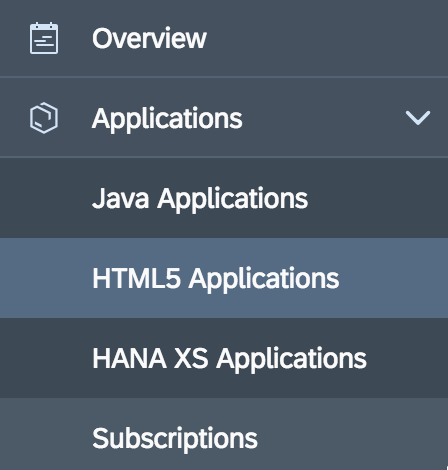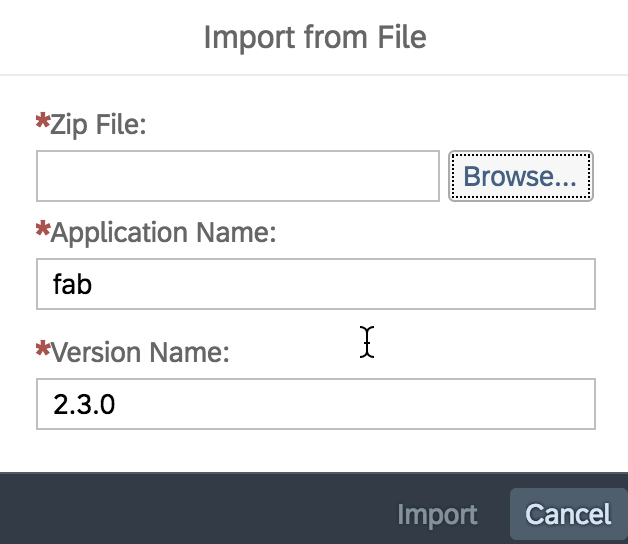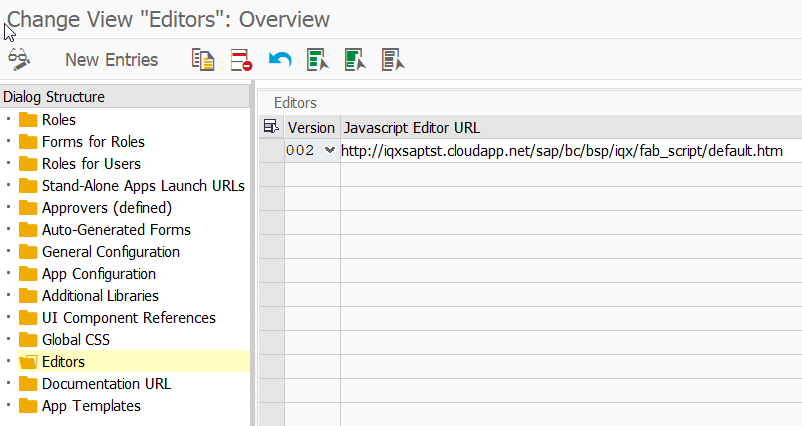NEO Cloud Deployment and Configuration
Deploying and running your applications to the SAP Cloud Platform (SCP) requires the base FAB application to be installed. The FAB application is provided as a ZIP file that can easily be imported. Once the core application is installed, it will allow you to run any of your dynamic applications without the need for further application installation. The only requirement for this is that SCP's OData Provisioning Service is used to serve up all your OData services. If the services are being served from the SAP Gateway system on-premise, then special care must be taken in how the service URLs are referenced as in an SCP deployment, the application is running in the SCP space (https://[app-name].dispatcher.hanatrial.ondemand.com) and the services will be served from another server. This means that relative URLs will not work in this scenario.
Performance
Those apps requiring the best performance via the use of standard caching techniques are candidates for individual installation into the SCP platform. Instructions to install individual applications is described below.
The FAB application consists of the following UI5 Apps the require deployment to SCP:
- Fab App - BSP: /IQX/FAB2
- Icon picker – BSP: /IQX/FAB_ICONS
- J editor (for data report) – BSP: /IQX/JSON_EDIT
- Process editor – BSP: /IQX/PROCESS_EDIT
Each of the apps should be installed on the cloud platform following the instructions below. Please note that the Icon Picker, Jason Editor, and Process Editor apps do NOT need to be configured onto the Fiori launchpad.
Post-deployment, the above three apps need to be configured in the IQX FAB Configuration: /IQX/FAB_CONFIG →Editors (See below)
Installing the FAB Application into your SCP Instance
- Log into the SAP Cloud Platform Cockpit
- Expand the Applications menu group on the side and select HTML5 Applications
- Select the Import from File option
- Upload the FAB SCP Install ZIP file and provide details for the Application Name (fab) and Version Name (Version number in major.minor.patch format. e.g. 2.3.0)
- Once the upload is complete, ensure the application shows "Started" in the status column. The application is not started, click the play button in the actions column.
Installing the FAB Framework into SCP Instance (correct steps)
- Log into the SAP Cloud Platform Cockpit
- Open WebIDE
- From the Menu select File → Import → File or Project
- Select the fab2.zip file to import (supplied by IQX)
- Select/Enter the Import folder (e.g. /fab)
- Once the import has completed, right-click on the new fab project in the Workspace tree
- Select Deploy → Deploy to SAP Cloud Platform
- Select Deploy a new application and click on Deploy
- After Deployment completed successfully, you have the option to Deploy the application to the SAP Fiori Launchpad (not required)
- Repeat steps 1 to 8 for the Icon Picker, Jason Editor, and Process Editor apps (only applicable to the Development environment)
Installing your Custom Applications into SCP
Option 1: Using Eclipse
- Convert the app to an offline application using the standalone and offline checkboxes in the property dialog within the FAB developer workbench. (FAB already exists as a BSP/standalone application)
- Use Eclipse to extract the application. (See here for details - Exporting an Application using Eclipse)
- Right-click the web-content folder and export to an archive.
- Open the archive and rename the web-content folder to webapp. (Zip again if necessary)
- Open up the WebIDE full-stack.
- Create a new project.
- Right-click on the newly created project and use the Import from file option.
- Use the ZIP file you created.
Deploying FAB Core to SAP Systems lower than 740
This is the recommended approach when working on a SAP version lower than 740. The reason being is that the ADT service/node will not be available in those systems and using SAP WebIDE to access the SAPUI5 repository will not work.
Option 2: Using SAP WebIDE
- Convert the app to an offline application using the standalone and offline checkboxes in the property dialog within the FAB developer workbench. (FAB already exists as a BSP/standalone application)
- Ensure you have a Destination created for the HTTP connection to the required SAP backend
- Open SAP WebIDE
- Go to the Home page
- At the bottom, there should be an Import from SAP UI5 Repository option
- Select the destination for the SAP system
- Search for the application and select it.
- After the import, right-click on the Web-Content folder and rename to webapp
VERY IMPORTANT
You may also need to manually copy the following folders and files into the project once created.
- /controls
- /core
- /scripts
- /searchHelps
- /Formatter.js
- /userFunctions.js
FAB Configuration for Icon Picker, Jason Editor and Process Editor Apps.
Navigate to the /IQX/FAB_CONFIG transaction. Open the Editors tab:
Configure the JavaScript Editor URL
http:// <SAPNWGWServer:port>/sap/bc/bsp/iqx/fab_script2/default.htm
Page across to the Left >
Configure JavaScript Editor Help URL:
http:// <SAPNWGWServer:port>/sap/bc/bsp/iqx/fab_help_s/index.html#File:fab.js
Page across to the Left >
2. Configure the Icon Picker URL: https://fabicons-<ScpID>.dispatcher.<region>.hana.ondemand.com/
e.g. - https://fabicons-ks8thsdld8.dispatcher.ap1.hana.ondemand.com
Page across to the Left >
3. Configure the Process (Workflow) Editor URL: https://processedit-<ScpID>.dispatcher.<region>.hana.ondemand.com/?hc_reset
Page across to the Left >
4. Configure the JSON Editor URL: https://jsonedit-<ScpID>.dispatcher.<region>.hana.ondemand.com/webapp/index.html




